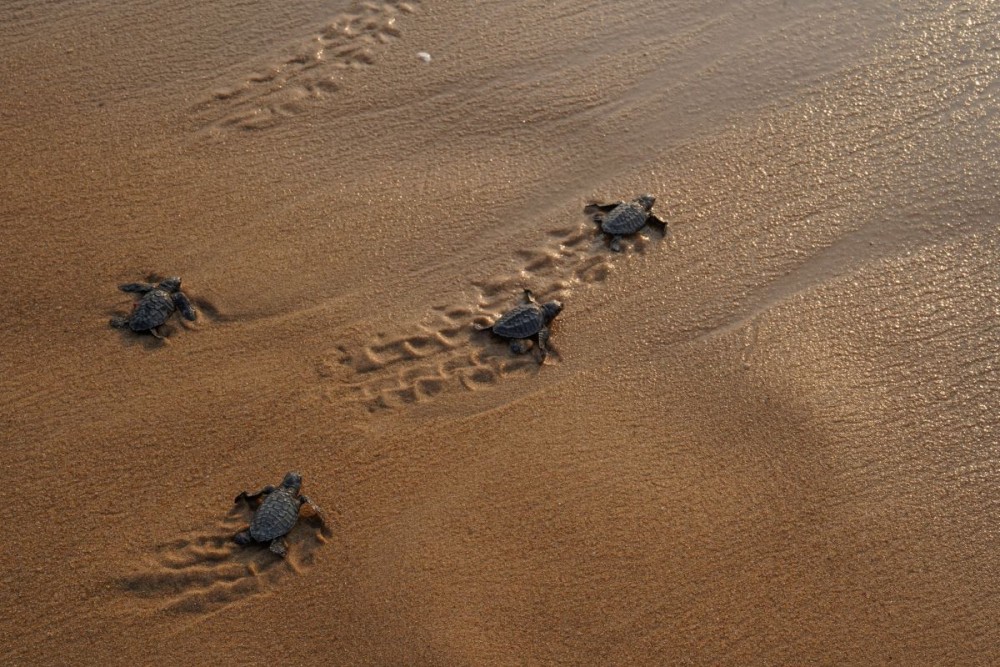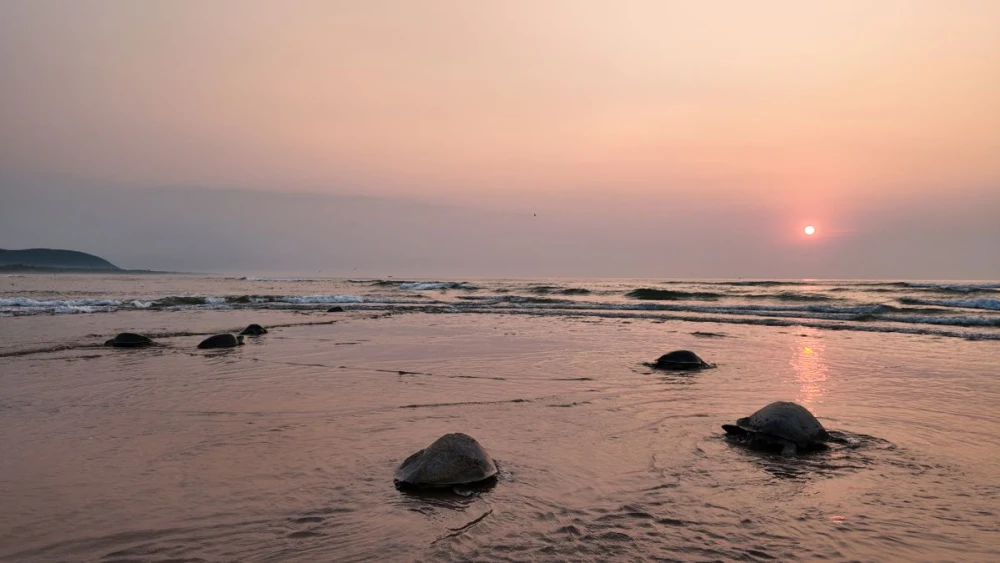Hatchlings (Photo Courtesy: Aniketa Kabir)

Jaya Peter
Associate Director, Communications, ATREE
Spanish for “Arrival by sea”, Arribada is the unique mass nesting behaviour shown by olive ridley and kemp ridley turtles which is seen along the coasts of Odisha (Gahirmatha and Rushikulya). This wildlife spectacle is known to occur only along the coasts of Mexico, Costa Rica and Odishain India.
In February, the Rushikulya rookery in Ganjam district of Odisha witnessed a record breaking Arribada that lasted 8-9days. The forest department put the counts toup to7 lakh nesting Olive ridley turtles. It was a moment celebrated by conservationists, especially since the turtles had given Rushikulya a miss the previous year.
Sea turtles are creatures of the sea. However, once every year, in a synchronised manner, along the Atlantic, Pacific and Indian ocean, the female turtles make the long journey back to their place of birth to lay eggs. The male turtles never come to land once they crawl into the sea as hatchlings.
I travelled to Rushikulya when I heard that a second mass nesting was occurring. It was not often that you hear about two mass nesting events in a year. In the last 20 years, it has only occurred once, in 2018.
Olive ridley turtles feed in the open sea and migrate closer to the shore during the breeding season. Around October-November, the male and female olive ridley turtles begin to congregate near the offshore waters of Rushikulya, with males arriving before females. Mating takes place a few kilometres in the sea close to the shore. Males return to their feeding grounds after mating while the female olive ridley turtles remain in the near shore waters till they are ready to nest. From December till May, they head onto the beach to find a place to lay their eggs.
We went prepared for the march heat in Odisha, not really convinced when we were told to carry a light jacket. The forecast read 32 degrees.
It was sunny when we reached Bhubaneshwar. As we drove to Ganjam, the sun vanished. Dark clouds, pregnant with water loomed over the horizon. The locals call this the ‘Kala Baisakhi’, a phenomenon that occurs between March and the onset of the monsoons. It is characterised by sudden changes in weather, strong winds, thunderstorm, lightning and rain.

At Ganjam, mass nesting occurs on a 3-4 km stretch on the beaches extending north of the Rushikulya river mouth. At the field station run by an NGO, Dakshin foundation, we were briefed on how to conduct the turtle count using the strip transect method. Each of us were in groups of three, two volunteers with a field staff/researcher who would lead the count.
Dakshin foundation has been monitoring this population of olive ridleys here since 2008.We listened in awe about the counts from the recent Arribada and the story of the discovery of Rushikulya beach as a mass nesting site.
In the 1990’s, researchers from the Wildlife Institute of India(WII) surveying the Odisha coast for turtle nesting met a fisherman Dambru from Purnabandha village who seemed to know about sea turtle nesting in large numbers. They left a few self-addressed postcards with him with instructions to send word in case he observes a mass nesting event. A few months later, Dambru Behera cycled 142 kms to Bhubaneshwar to send a message announcing that the mass nesting had begun. The researchers set out soon but didn’t arrive in time. So, they stayed on to witness the hatchlings emerge enmass.
As we waited at the field station aptly called the sea turtle base, local staff wondered if rain would deter the turtles from arriving tonight. Since we were here only for a night, we hoped that the urge to lay eggs supersede the bad weather.
After an early dinner, we picked up some biscuits and cream buns for the night and headed to the old podampetta village. The rising sea levels have engulfed a large section of this village. In 2015, 200 houses were washed away by the rising tide. Only 2 families remain.
As we reached the beach, it began to rain heavily. Surendra Behera, a local field staff, took us to the forest department’s tent on the beach. As we sat waiting for the rain to stop, I looked around. There were 17 of us, 15 men and two women, squeezed into a small tent, the edges of which were dripping with rainwater. Three of us had travelled here while the rest were locals. The men offered space generously. Every now and then, the men would check the side of the tents, raise the sand near the edge to make a ridge so that rain water doesn’t flow in.
As we waited, we were introduced to one of the field staff Bipro who was leading one of the groups counting the nesting turtles. We learnt that it was Bipro’s father, the late Dambru Behera who discovered the mass nesting of turtles here. Bipro has been working towards the conservation of Olive Ridley turtles for the last 17 years.
By 10 pm, the rain had stopped and we headed out for our first count of the night.
The moon had not risen but the turtles had already come in large numbers! We watched as wave upon wave of turtles made their way onto the beach.
We could see what looked like bobbing helmets in the sand, moving in slowly like an army. There were turtles everywhere, some crawling looking for a correct spot to lay eggs, some were sending sand flying around as they dug with their flippers, some were taking a breather before moving again. We walked carefully, trying not to step on a flipper. Holding a five-meter rope stretched, we walked the beach from shore line towards the tree line counting the number of egg laying/Ovi positioned turtles.
A turtle takes around an hour to find a suitable spot, dig a pit in the sand, lay eggs, cover the nest with sand and return to sea. Hence the researchers conduct counts every hour. The act of laying eggs or Ovi positioning takes 18 to 22 minutes. The turtles need to dig 1-2 feet into the sand before they position themselves and start laying eggs. The nesting turtle has its front flippers curled out in a V and its hind flippers stretched out behind. It sits an angle with its cloaca dipping into the nest. Our task was to identify this nesting turtle posture and record the count. We had 4 segments to cover each hour.
It wasn’t easy to identify the nesting posture. Sometimes the turtles would seem to be in position, but they will begin to dig again or do a false crawl where they abandon the nesting attempt.
As we walked, we heard the locals say that perhaps, the rain is good. It has loosened the sand and the turtles are able to dig more easily. We adapt to the shifting narratives.
Nesting trance
Once the turtles position themselves on the pit they have dug, they go into a ‘nesting trance’. In their search for a suitable place to nest, turtles crawl over each other, some drag themselves to the edge of the beach, dig through the barricades to the tree line where there is no sand. We saw the field staff move a few straying turtles back to the sand area. With eyes half closed, they sometimes stretch out their neck, raise their head in the effort to push the egg out. Each push yields 1-3 eggs with some cloacal fluid released. Much like water breaking in humans, I thought. The Olive ridley turtle lays 100to 150 eggs on an average. Once done, it covers the nest with sand after which it does a gentle sideways rocking motion as it settles the sand with a series of dull thuds until the surface of the nest is smooth. It then makes its way towards the sea. Looking at the spot, one cannot tell that a turtle has just laid over 100 eggs.
Bioluminscence
As the night progressed, we became more adept at identifying the nesting posture. We recorded two turtles with metal tags on their flippers.
The count in each section kept increasing by the hour and we struggled to keep up with Surendra as he navigated the beach stretch.
By 2 am, the moon came out, an orange disc shaped like a segment of a tangerine reflecting in sea. In the moonlight we could see the waves and a clearer outline of turtles. Near the shore, we noticed that the colour of the waves were fluorescent.
Bioluminescence!!
Very excited, we looked towards Surendra who confirmed it. As we stood with our feet in water and splashed the waves with our feet, blue and green colours lit up the sea. Surender bent and rubbed his hands over the carapace of a turtle. The turtle’s carapace glowed a neon blue shade.
During the first Arribada, turtles had started coming in from 4-5pm. That meant the team were doing counts every hour from 6pm till 7am the next morning. It is a tough job to walk12 to 13hours through the night for eight days without a break.
As each hour passed, it became increasingly difficult to get up and plough through the sand, carefully stepping over the turtles and documenting each segment. As a mixture to sleep and fatigue hit me, I followed Surendra in a haze as he set the rhythm, walking and meticulously counting for half hour, taking small cat naps before resuming the count.
The wind was picking up and it was getting very cold. The biscuits and the cream buns helped bring some energy and focus back as we sat shivering in the sand, leaning against a fishing boat to beat the cold draft on the moonlit night beach surrounded by turtles in a trance.
The turtle numbers that had peaked from 12am to 3am had decreased now. The last of the turtles were making their way in to lay eggs. In about 45-50 days, the eggs would hatch and the hatchlings would crawl out of their nests and head into the ocean. The hatchlings have to make their way across the beach where predators like the jungle cat, feral dogs, feral pigs, birds of prey lurk.
They navigate following the light from the moon but the light pollution from the highway or neighboring towns can cause a similar glow and disorient them. The sex of the turtle hatchlings is temperature dependent. With the global temperatures rising, the sea turtle populations might become increasingly feminised.
Are hatchlings from the same nest connected by sibling bond?
Do they stay together once they hit the sea or do they head out on their own?
We don’t really know.
By 5:30, the dawn begins to break. The beach stretched out before us full of turtle tracks. The turtles have etched their story in the sand.
In the morning light, we could see the turtles, tired, pushing themselves over the last stretch of sand before they hit the water. Once in water, they dive gracefully in and swim fast. Their neck sticks out in water at a distance as they head away from the shore into the deep sea. Studies from the satellite monitoring of turtles have revealed that while some of the Olive Ridley turtles remain in the offshore waters of Odisha, many others migrate to Sri Lanka and the Gulf of Mannar.
Looking into the sea, one can only marvel at the interconnectedness of the universe, the invisible chord that triggers an Arribada, that connects thousands of starlings in a murmuration, or a swarm of fireflies that glow together in perfect synchrony. Perhaps a reminder to us to value our connection to the universe and respect the internal rhythm that nurtures this harmony.



